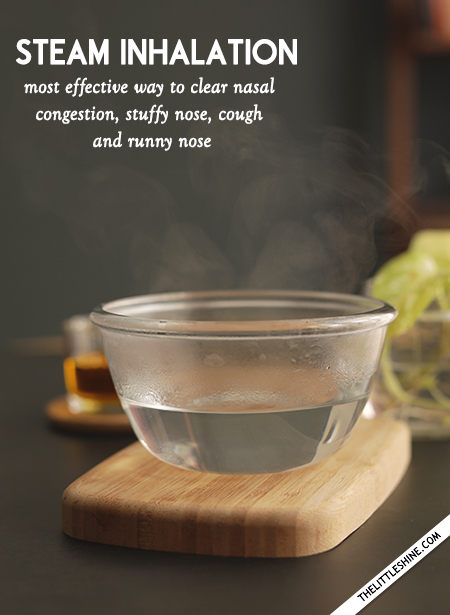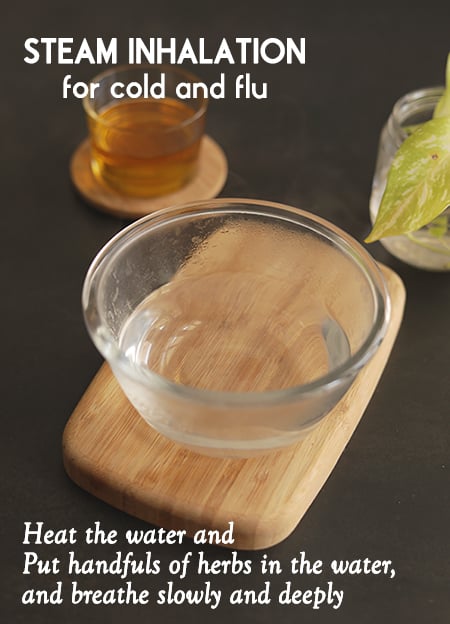Steam inhalation or steam therapy is a common practice followed by many. It is widely used as a home remedy to ease and soothe coryzal symptoms (acute inflammation of the mucous membrane of the nasal passage) like nasal congestion, head cold, sinusitis, cough, acute rhinitis or stuffy nose, nasal allergies, to soothe headaches due to sinusitis etc. steam inhalation or steam therapy is nothing but the inhalation of water vapour.

Benefits of steam inhalation:
Steam inhalation can help relieve a stuffy nose. A stuffy nose or acute rhinitis is caused by the inflammation of the triggered blood vessels of the sinuses and it can be due to upper respiratory tract infections. When we breathe in the moist air, it can ease the feelings of irritation caused by the blocked nasal passage and can help thin out the mucus (a thin secretion made by the nose and sinuses) in the sinuses. It can thereby make the breathing process easier and provide temporary relief, if not permanent solution, as it doesn’t kill the virus responsible for the infection. It is also useful for treating the symptoms of common cold, bronchitis (inflammation of the bronchial tube causing mucus build up), cough (by helping the phlegm or the thick secretion from the throat and lungs to be released as it provides an expectorant effect), chest congestion, nasal allergies etc.

Here’s how you can steam inhale if you do not have a steam inhaler or steam vapourizer at home:
You will require:
- A large bowl or vessel
- A bath towel
- Herbs or Essential oils like eucalyptus, peppermint oil etc (optional)
Step 1: In a deep bottom vessel, fill in water (to fill up around a quarter to half of the vessel) and heat it on the stove until it becomes hot.
Step 2: Keep a hot pad or small towel and place your heated vessel on top of it, on the table and be seated on the chair, so that both you and the vessel are at the same height. (keep the vessel covered till you begin, so that the water doesn’t cool down and the steam doesn’t escape).
Step 3: Add in herbs like peppermint, thyme or a drop or two of essential oil (to provide an enhanced expectorant effect of bringing out the clogged up mucous or phlegm), only if you wish to or else you can skip this step and it will still give you the desired results.
Step 4: Cover your head with a large towel and lean over the bowl and see to it that the bowl too is covered with the towel, creating a tent like seal around you, so that the steam remains within and doesn’t escape. Maintain a safe space between the bowl and your head, as you do not want to get burnt or scalded because of the heat. If it is too hot, wait for it to cool down a little and after a few seconds you can start your steam inhalation process.
Step 5: Breathe in through your nose and mouth and continue this for around 5 to 8 minutes or until you find your nasal passage is clearing up.
Caution and safety precautions while practicing steam inhalation:
- Do not lean in or bring your head too close to the hot water/steaming water, as it can cause scalding or can cause harm to your nasal passage.
- Keep the heated vessel/bowl on a sturdy and steady surface and away from the edge of the table.
- Be careful when you follow this practice with small children around. Children should avoid this practice, for safety reasons (like burns and scalding) and can follow the practice given below.
- Keep your eyes shut while inhaling and those wearing contact lenses are advised to remove them before doing a steam inhalation.
Since children will not be able to do this inhalation, as it may not be very safe (unless they are able to understand how to do it and do it with the guidance of a trusted adult), this practice can be followed to provide a similar effect for them.
Here’s what you can do:
You can create a steam room for the child, either by using a steam vapourizer bought from the store or you can let your shower in the bathroom run for a few minutes (with the bathroom door shut, so that the steam and heat gets trapped inside) and soon the bathroom will be steam filled and be heated. Then sit in the bathroom with your child and let him/her breathe in through both the mouth and nose for around 10 minutes.
